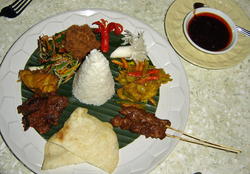 | |
| Alternative names | Nasi rames |
|---|---|
| Course | Main course |
| Place of origin | Maritime Southeast Asia |
| Associated cuisine | Indonesia, Malaysia, Brunei, Singapore and southern Thailand |
| Serving temperature | Hot or room temperature |
| Main ingredients | Rice with various side dishes |
| Variations | Nasi campur Bali, nasi padang, nasi rames, nasi kandar, rijsttafel (Indo) |
| Other information | Also popular in the Netherlands |
Nasi campur (Indonesian and Malay for 'mixed rice'), also known as nasi rames (Javanese: ꦤꦱꦶꦫꦩꦼꦱ꧀, romanized: nasi raměs, lit. 'mixed rice') or sego campur (Javanese: ꦱꦼꦒꦕꦩ꧀ꦥꦸꦂ, romanized: sěgå campur; [sə'gɔ ˈtʃampur]) in Java, refers to an Indonesian and Malay dish of a scoop of nasi putih (white rice) accompanied by small portions of several other dishes, which includes meats, vegetables, peanuts, eggs, and fried-shrimp krupuk.[1]
Depending on the origin, a nasi campur vendor might serve several side dishes, including vegetables, fish, and meats.[2] It is a staple meal from Indonesia, Malaysia, Singapore, Brunei, and southern Thailand, and also popular in the Netherlands through its colonial ties with Indonesia. A similar form called chanpurū exists in Okinawa.
This concept has parallels across Asia and the Pacific: in Thailand, it is known as Khao kaeng (Thai: ข้าวแกง), in Vietnam as Cơm bình dân. In the Philippines, the Carinderia offers a similar meal style, and in Japan, it is called as Ichijū-sansai. Similarly, in Hawaii, it is known as the Plate lunch, and in Mariana Islands, it is referred to as the "Fiesta Plate". However, in the Indonesian and Malay-speaking regions, the term nasi campur is the most commonly recognized name for this style of meal.
- ^ Ashlee Betteridge (2 April 2010). "Nasi Campur: Rice With a Side of Serendipity". JakartaGlobe. Retrieved 4 July 2014.
- ^ "Nasi Campur (Malay Mixed Rice)". Backpacking Malaysia. Retrieved 6 July 2014.